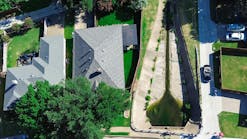Sediment Pollution Reduced by Skimming
Traditional sediment basins were built with a porous stone dam intended to hold muddy water while the sediment settled, then drain clean water downstream. Unfortunately, these were not very efficient, which would be proven by the sediment visible downstream from the basin. A study in Maryland found that these types of basins capture less than 50% of sediment. The downward pressure of water in these basins causes them to drain from the bottom, releasing the water with the heaviest concentration of sediment in the basin. Furthermore, the debris line on the sides of the basin revealed that the basins never fill even during a heavy rain.
Warren Faircloth, the erosion control supervisor for Orange County, N.C., at the time, observed this sediment pollution and began pondering how to drain the cleanest water from the surface of the basin. His first skimmer was tested at Columbia Place, a housing development in Orange County. After waiting months for rain, he rushed to the basin after the first deluge to see the results. He found minimal amounts of sediment downstream from the outlet, a visible and dramatic proof that the skimmer could make a difference.
Faircloth continued testing and improving the skimmer over many years, resulting in the Faircloth Skimmer surface drain. When combined with porous baffles and proper basin size and shape, the Faircloth Skimmer surface drain has demonstrated 90% efficiency after research at Penn State University and North Carolina State University. This skimmer available in multiple sizes, is simple to install and can be easily customized on site to provide the required flow rate. It works by gravity and requires no pump to function as long as there is positive flow out of the basin. Use of a surface drain now is considered a BMP for sediment basins.
Download: Here






